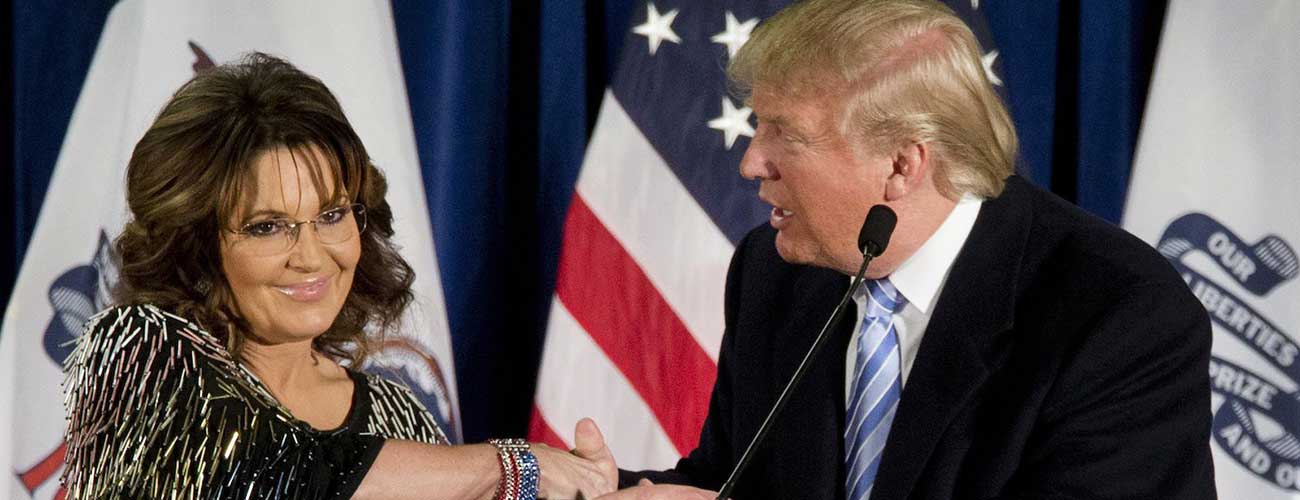She’s back. Sarah Palin made her triumphant return to the national media spotlight this week, endorsing Twitter savant and Republican frontrunner Donald Trump. “Media heads are spinning,” Palin said during a speech that bordered on free association.
Indeed, the following 48 hours saw a rash of Palin stories, reminding us how the former VP candidate’s mastery of attracting attention may be second only to Trump’s. More than 4.5 million people “Like” her Facebook page, almost as many followers as the man himself. Both straddle the line between anti-establishment politician and reality TV superstar.
It’s no surprise, then, that the quick evolution of Palin coverage this week bore striking resemblance to the rough trajectory of media mania seen throughout Trump’s campaign. The five stages of Trump coverage, a path to media sobriety explained through Palin, are as follows:
Amusement
“It has been described as performance art, a filibuster, even slam poetry,” The New York Times deadpanned in its attempt to decode Palin’s endorsement. The speech was meandering at best—she wasn’t “pussyfooting around”—so it’s hard to blame journalists for remarking upon a truly odd spectacle on the campaign trail. Besides, what was she wearing? The Twitterati feasted on head-scratching one-liners captured for posterity through Vine. It made for good internet.
So, Uh, Here’s The Full Text Of Sarah Palin’s Bizarre Trump Speech https://t.co/kFlF1Yjlrv https://t.co/iwZFgpY5Wl
— BuzzFeed News (@BuzzFeedNews) January 20, 2016
The early days of Trump’s campaign likewise resembled self-parody. But news organizations ran with that notion for far too long, implicitly or explicitly covering the irreverent showboater as mere entertainment. In doing so they not only underestimated Trump’s durable appeal, but also coddled him for ratings and traffic.
Disbelief
Is this real life, or some sort of Borowitzian alternate reality? After Palin made a follow-up stump speech on Wednesday, journalists took stock of whether she actually said all the things they thought she said. For one: Did Palin kinda, sorta blame her son’s recent domestic abuse arrest on Obama? The media did a double take, and CNN asked Trump directly whether he had sanctioned the comment.
Trump’s nascent campaign last year consistently shocked and confused the political press with his ability to turn conventional wisdom on its head. Journalists’ fixation on Trump’s theretofore unbelievable polling strength played into his hands by showcasing a man who can defy odds—it was inherently positive coverage. One look at his Twitter feed, where he trumpets each new survey to his nearly 6 million followers, makes that argument hard to dispute. Luckily for all of us, the novelty has worn off.
Deliberation
After Palin’s outlandish speeches, news organizations began parsing whether endorsements even matter—their answers were all over the map. This more measured stage of coverage also saw sharp analyses of how Trump and Palin hail from the same political lineage, and what their alliance says about the broader fissure within the Republican Party.
Nuanced coverage of Trump’s campaign and appeal likewise took time to develop. After all, both are unique to recent political history. But the past few months have seen increasingly serious examinations of what the Trump phenomenon means: take The Atlantic’s recent cover story on the GOP’s civil war, or The Washington Post’s e-book on how Trump single-handedly changed the 2016 race. Polling experts, meanwhile, have drilled down into data to dissect who Trump supporters are, and what motivates them. This vein of analysis has continued amid shifts to later stages of Trump coverage, all the more important as voting approaches.
Self Reflection
While Trump’s campaign is already a media circus, the Times wrote, “Mrs. Palin’s involvement in his campaign could help him deprive [Ted] Cruz of attention in the homestretch to the caucuses.” Many breakdowns of Palin’s endorsement similarly nodded to news organizations’ own role in the political process. Their so-it-goes nonchalance in this regard seemed to suggest that they had no control over what was published or broadcast.
The media, unquestionably, has been a huge story this cycle, and not only because Trump routinely bashes news outlets and individual journalists on Twitter. Trump has drawn a disproportionate share of mainstream political coverage, a fact that his sprawling field of competitors often criticizes to no effect. While that debate continues, coverage of Trump’s first ad buys passively acknowledged the free publicity he had received to that point.
Acceptance
By the time dust from Palin’s speeches settled, many journalists had come around to appreciating their value. “Sarah Palin’s Trump endorsement was a surprisingly substantive explanation of Trump’s rise,” read a Thursday headline from Vox. Brief forays into anti-establishment conservative media, like Rush Limbaugh or Breitbart News, likewise shed light on how Palin’s endorsement played with Trump’s target audience.
With the Iowa Caucus 10 days away, political media are similarly coming to grips with Trump as a legitimate frontrunner. Look no further than a recent piece by 538’s Nate Silver, long the most prominent voice casting doubt on Trump’s poll numbers. “I was skeptical because I assumed that influential Republicans would do almost anything they could to prevent him from being nominated,” Silver wrote. “But so far, the party isn’t doing much to stop Trump.”
Perhaps the only safe assumption for political media this cycle can be summed up as Trump’s Law: Anything that can happen, will happen.
David Uberti is a writer in New York. He was previously a media reporter for Gizmodo Media Group and a staff writer for CJR. Follow him on Twitter @DavidUberti.

